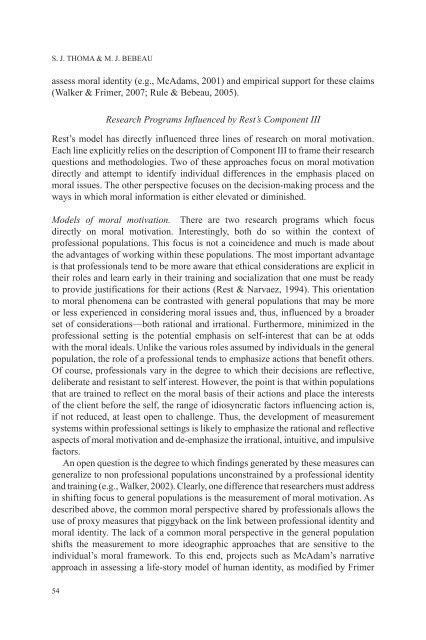Handbook of moral motivation: Theories, models ... - Sense Publishers
Handbook of moral motivation: Theories, models ... - Sense Publishers
Handbook of moral motivation: Theories, models ... - Sense Publishers
- No tags were found...
You also want an ePaper? Increase the reach of your titles
YUMPU automatically turns print PDFs into web optimized ePapers that Google loves.
S. J. THOMA & M. J. BEBEAUassess <strong>moral</strong> identity (e.g., McAdams, 2001) and empirical support for these claims(Walker & Frimer, 2007; Rule & Bebeau, 2005).Research Programs Influenced by Rest’s Component IIIRest’s model has directly influenced three lines <strong>of</strong> research on <strong>moral</strong> <strong>motivation</strong> .Each line explicitly relies on the description <strong>of</strong> Component III to frame their researchquestions and methodologies. Two <strong>of</strong> these approaches focus on <strong>moral</strong> <strong>motivation</strong>directly and attempt to identify individual differences in the emphasis placed on<strong>moral</strong> issues. The other perspective focuses on the decision-making process and theways in which <strong>moral</strong> information is either elevated or diminished.Models <strong>of</strong> <strong>moral</strong> <strong>motivation</strong> . There are two research programs which focusdirectly on <strong>moral</strong> <strong>motivation</strong>. Interestingly, both do so within the context <strong>of</strong>pr<strong>of</strong>essional populations. This focus is not a coincidence and much is made aboutthe advantages <strong>of</strong> working within these populations. The most important advantageis that pr<strong>of</strong>essionals tend to be more aware that ethical considerations are explicit intheir roles and learn early in their training and socialization that one must be readyto provide justifications for their actions (Rest & Narvaez, 1994). This orientationto <strong>moral</strong> phenomena can be contrasted with general populations that may be moreor less experienced in considering <strong>moral</strong> issues and, thus, influenced by a broaderset <strong>of</strong> considerations—both rational and irrational. Furthermore, minimized in thepr<strong>of</strong>essional setting is the potential emphasis on self-interest that can be at oddswith the <strong>moral</strong> ideals. Unlike the various roles assumed by individuals in the generalpopulation, the role <strong>of</strong> a pr<strong>of</strong>essional tends to emphasize actions that benefit others.Of course, pr<strong>of</strong>essionals vary in the degree to which their decisions are reflective,deliberate and resistant to self interest. However, the point is that within populationsthat are trained to reflect on the <strong>moral</strong> basis <strong>of</strong> their actions and place the interests<strong>of</strong> the client before the self, the range <strong>of</strong> idiosyncratic factors influencing action is,if not reduced, at least open to challenge. Thus, the development <strong>of</strong> measurementsystems within pr<strong>of</strong>essional settings is likely to emphasize the rational and reflectiveaspects <strong>of</strong> <strong>moral</strong> <strong>motivation</strong> and de-emphasize the irrational, intuitive, and impulsivefactors.An open question is the degree to which findings generated by these measures cangeneralize to non pr<strong>of</strong>essional populations unconstrained by a pr<strong>of</strong>essional identityand training (e.g., Walker, 2002). Clearly, one difference that researchers must addressin shifting focus to general populations is the measurement <strong>of</strong> <strong>moral</strong> <strong>motivation</strong> . Asdescribed above, the common <strong>moral</strong> perspective shared by pr<strong>of</strong>essionals allows theuse <strong>of</strong> proxy measures that piggyback on the link between pr<strong>of</strong>essional identity and<strong>moral</strong> identity . The lack <strong>of</strong> a common <strong>moral</strong> perspective in the general populationshifts the measurement to more ideographic approaches that are sensitive to theindividual’s <strong>moral</strong> framework. To this end, projects such as McAdam’s narrativeapproach in assessing a life-story model <strong>of</strong> human identity, as modified by Frimer54














